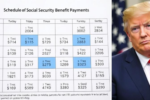An early estimate for the 2026 Social Security Cost of Living Adjustment (COLA) suggests that retirees may receive a much lower increase than expected.
The Senior Citizens League (TSCL), a non-partisan advocacy group, predicts that the 2026 COLA will be 2.1%, based on data from the Bureau of Labor Statistics’ CPI-W (Consumer Price Index for Urban Wage Earners and Clerical Workers). December’s CPI-W data stood at 2.8%, signaling a continued decline in inflation.
A Drop in COLA Increases Over the Years
If the 2.1% projection holds, it will be the lowest COLA adjustment since the COVID-19 pandemic began. In 2025, the COLA was 2.5%, a drop from 3.2% in 2024 and a significant fall from the 8.7% increase in 2023. The last time COLA was below 2% was in 2021, when it stood at 1.3%.
Seniors Struggle to Keep Up with Inflation
TSCL Executive Director Shannon Benton warns that even though inflation is cooling, seniors are still struggling financially.
“Slower inflation doesn’t mean seniors are catching up. Congress must act quickly to fix years of inadequate COLAs and help older Americans maintain a decent quality of life,” Benton said.
One major policy proposal that could provide relief is eliminating taxes on Social Security benefits. Benton points out that the income thresholds that determine whether Social Security benefits are taxed were established in the 1980s and haven’t been adjusted for inflation since then.
Most Seniors Rely Heavily on Social Security
According to TSCL’s 2024 Senior Survey, 67% of retirees depend on Social Security for more than half of their income. Even though inflation is slowing, it does not mean prices are dropping—only that they are increasing at a slower rate.
“Many seniors are facing a budget shortfall. Our survey shows that 62% of older Americans are worried that their retirement income won’t be enough to cover essentials like groceries and medical bills,” TSCL reported.
How COLA Is Calculated
Social Security COLAs are based on inflation data from the CPI-W, which tracks the average prices of goods and services. The average CPI-W from the third quarter (July, August, and September) of the previous year is compared to the same period in the current year. The percentage increase determines the COLA for the following year.
With the current trend of declining inflation, seniors may need to prepare for a much smaller COLA increase in 2026—a development that could make it harder for many retirees to keep up with rising costs.
Disclaimer – Our team has carefully fact-checked this article to make sure it’s accurate and free from any misinformation. We’re dedicated to keeping our content honest and reliable for our readers.







